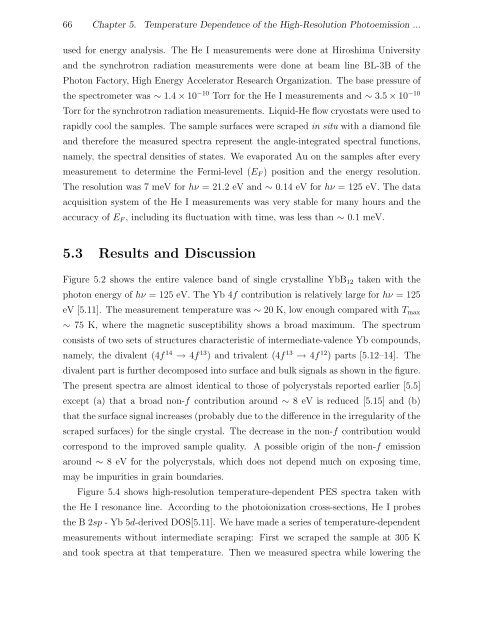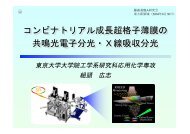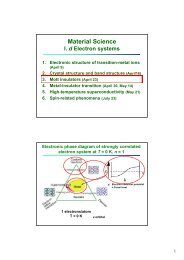Thesis High-Resolution Photoemission Study of Kondo Insulators ...
Thesis High-Resolution Photoemission Study of Kondo Insulators ...
Thesis High-Resolution Photoemission Study of Kondo Insulators ...
You also want an ePaper? Increase the reach of your titles
YUMPU automatically turns print PDFs into web optimized ePapers that Google loves.
66 Chapter 5. Temperature Dependence <strong>of</strong> the <strong>High</strong>-<strong>Resolution</strong> <strong>Photoemission</strong> ...<br />
used for energy analysis. The He I measurements were done at Hiroshima University<br />
and the synchrotron radiation measurements were done at beam line BL-3B <strong>of</strong> the<br />
Photon Factory, <strong>High</strong> Energy Accelerator Research Organization. The base pressure <strong>of</strong><br />
the spectrometer was ∼ 1.4 × 10−10 Torr for the He I measurements and ∼ 3.5 × 10−10 Torr for the synchrotron radiation measurements. Liquid-He flow cryostats were used to<br />
rapidly cool the samples. The sample surfaces were scraped in situ with a diamond file<br />
and therefore the measured spectra represent the angle-integrated spectral functions,<br />
namely, the spectral densities <strong>of</strong> states. We evaporated Au on the samples after every<br />
measurement to determine the Fermi-level (EF ) position and the energy resolution.<br />
The resolution was 7 meV for hν = 21.2 eV and ∼ 0.14 eV for hν = 125 eV. The data<br />
acquisition system <strong>of</strong> the He I measurements was very stable for many hours and the<br />
accuracy <strong>of</strong> EF , including its fluctuation with time, was less than ∼ 0.1 meV.<br />
5.3 Results and Discussion<br />
Figure 5.2 shows the entire valence band <strong>of</strong> single crystalline YbB12 taken with the<br />
photon energy <strong>of</strong> hν = 125 eV. The Yb 4f contribution is relatively large for hν = 125<br />
eV [5.11]. The measurement temperature was ∼ 20 K, low enough compared with Tmax<br />
∼ 75 K, where the magnetic susceptibility shows a broad maximum. The spectrum<br />
consists <strong>of</strong> two sets <strong>of</strong> structures characteristic <strong>of</strong> intermediate-valence Yb compounds,<br />
namely, the divalent (4f 14 → 4f 13 ) and trivalent (4f 13 → 4f 12 ) parts [5.12–14]. The<br />
divalent part is further decomposed into surface and bulk signals as shown in the figure.<br />
The present spectra are almost identical to those <strong>of</strong> polycrystals reported earlier [5.5]<br />
except (a) that a broad non-f contribution around ∼ 8 eV is reduced [5.15] and (b)<br />
that the surface signal increases (probably due to the difference in the irregularity <strong>of</strong> the<br />
scraped surfaces) for the single crystal. The decrease in the non-f contribution would<br />
correspond to the improved sample quality. A possible origin <strong>of</strong> the non-f emission<br />
around ∼ 8 eV for the polycrystals, which does not depend much on exposing time,<br />
may be impurities in grain boundaries.<br />
Figure 5.4 shows high-resolution temperature-dependent PES spectra taken with<br />
the He I resonance line. According to the photoionization cross-sections, He I probes<br />
the B 2sp -Yb5d-derived DOS[5.11]. We have made a series <strong>of</strong> temperature-dependent<br />
measurements without intermediate scraping: First we scraped the sample at 305 K<br />
and took spectra at that temperature. Then we measured spectra while lowering the






